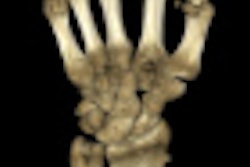Sunday, November 28 | 10:55 a.m.-11:05 a.m. | SSA19-02 | Room S403B
Researchers from the Medical University of South Carolina in Charleston will discuss how reader experience affects the benefits of computer-aided detection (CAD) in coronary CT angiography (CCTA).Seeking to evaluate the effects of CAD on different experience levels for evaluating coronary artery stenosis on CCTA, the team had five observers evaluate CCTA studies from 50 patients for the presence of 50% or greater stenosis. Three months later, the observers again read the studies with the use of Cor Analyzer software (Rcadia Medical Imaging, Auburndale, MA).
Although CAD positively affected all readers, the inexperienced readers benefited the most. By using CAD, interpreters may be reassured by their exclusion of significant stenosis based on a normal or near-normal CCTA, said co-author Christian Thilo, MD.
"This may be particularly helpful for interpreters at the beginning of their learning curve or in on-call situations where relatively inexperienced trainees are increasingly called upon to rule out significant coronary artery stenosis in patients with acute chest pain using CT," Thilo told AuntMinnie.com.





















